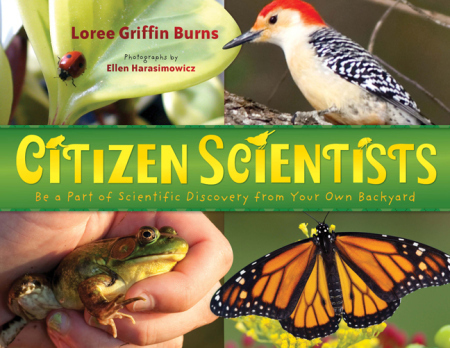Citizen Scientists
Photographs by Ellen Harasimowicz
Henry Holt, 2012
ISBN #9780805095173
Grades 3-7
Nonfiction
“It’s not a phrase you hear every day, and it doesn’t exactly roll off the tongue. But citizen science is the beating heart of this book, so we’d better start by defining it.”
“Citizen science, then, is the study of our world by the people who live in it.”
Swing a net to catch a monarch butterfly. Count birds in the winter. Identify frog calls in the spring. Sweep a net to identify ladybugs in the summer. You’ll be a scientist, too.
Citizen Scientist is a fascinating narrative combined with carefully explained sets of procedures that sweeps readers into the world of science that they can do. Their participation becomes a significant part of real life scientific research and teaches young people the skills and values of science in their lives.
Burns’s book takes readers on an adventure that leads them directly into the world of science that is found in their own neighborhood. It gives kids the power to contribute to the body of knowledge about the four animals discussed in the book: monarch butterflies, birds, frogs, and ladybugs. Her second person narrative is friendly and encouraging, giving the reader the sense she’s talking directly to them. Each section has a checklist for the equipment and gear needed to study that animal. Additional information is included about the specifics of each of the animals’ studies. This information is enhanced by the lovely photographs by Harasimowicz.
A “Now What?” section give resources for each animal about books and sources for more facts and the groups that organize the information presented in the book. More resources, quiz answers, a bibliography, and glossary round out the back matter.
I heard Loree talking about this book last year and wondered what it would be like. She’s hit on a terrific format that puts kids directly into science in a fun, meaningful way. This book hits the Common Core Standards perfectly and is likely to inspire budding scientists and novices alike to be involved. It’s a book for everyone—kids, parents, teachers, and librarians. Who knows what future scientist will get her or his start by reading this book?
Activity
Choose one of the animals and look up the organizations that work with studying it. Find out more about how you can become involved. Make a model of the butterfly or ladybug, or learn two or three frog calls. Check out a bird book and identify three birds in your backyard. Then maybe you’ll participate in one of the events talked about in the book.
Resources: Check out the extensive list Burns added to the back matter for more information.
Here’s a review from 100 Scope Notes.
National Science Standards: biodiversity and humans; applied science
Book provided by Henry Holt and Company BFYR


Shirley Smith Duke's Blog




